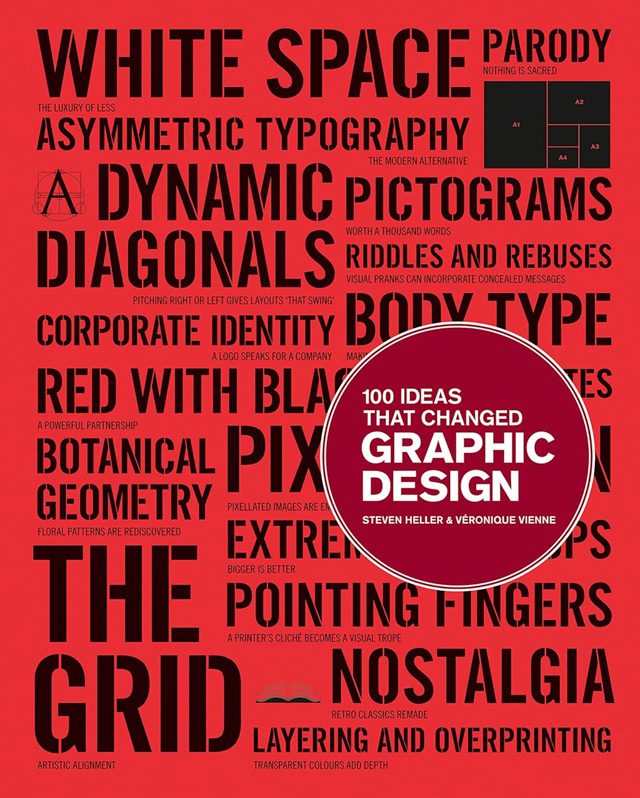
Steven Heller and Véronique Vienne’s 100 Ideas That Changed Graphic Design is a monumental exploration of the concepts that have defined and redefined graphic design over centuries. Published in 2012, the book is a cornerstone for understanding how historical events, artistic movements, and technological innovations shaped the practice of graphic design into what it is today. Its blend of compelling narratives and stunning visuals makes it a rich resource for both inspiration and education.
Authors’ Expertise and Vision
Steven Heller, a prolific design historian, and Véronique Vienne, an acclaimed art director, are both highly influential figures in the world of graphic design. Heller has authored or co-authored over 180 books on design and popular culture, making him one of the most prominent voices in the field. His extensive career includes decades as an art director at The New York Times, where he helped shape visual journalism. Vienne, on the other hand, is celebrated for her innovative work in art direction and her thought-provoking books and essays on design. Together, they bring a wealth of complementary expertise to this project.
Heller’s deep understanding of design history lends the book a scholarly rigor, connecting each idea to its historical and cultural context. He provides insights into how these concepts evolved over time and influenced both designers and society. Vienne complements this with her keen eye for aesthetics and a focus on the practical, everyday application of design principles. Their collaboration is built on a shared vision of design as both a creative craft and a reflection of broader cultural trends, resulting in a book that is as intellectually enriching as it is visually engaging..
Organization and Content Overview
The book is structured into 100 bite-sized chapters, each dedicated to a specific idea that has left a mark on graphic design. These ideas span technical innovations, cultural movements, aesthetic principles, and industry practices. Examples include:
- The Grid System: The backbone of modernist design, allowing for organized and visually balanced layouts.
- Helvetica: A typeface synonymous with neutrality and functionality, symbolizing the modernist ethos.
- Postmodernism: A reaction against modernism’s rigidity, characterized by eclectic, playful, and ironic design choices.
Each chapter features a brief yet illuminating essay accompanied by vivid imagery, illustrating how these ideas were implemented in practice. The visuals are not mere decorations; they act as critical tools for understanding the real-world impact of the concepts discussed.
Highlights of Key Ideas
Typography as a Design Element
Typography forms the heart of graphic design, and the book dedicates several chapters to its evolution. Discussions on “Helvetica” and “Experimental Type” highlight how typography has been used to communicate tone, identity, and emotion. The entry on “Body Type,” for instance, explores the use of lettering on the human form, reflecting how typography extends beyond paper and screens into physical and cultural contexts.
Pictograms and Universal Communication
The chapter on “Pictograms” illustrates how simple, universally recognizable symbols have been used to bridge language barriers. From Olympic Games signage to modern digital icons, pictograms demonstrate the power of graphic design to create systems of communication that transcend linguistic differences.
The Impact of Technology
Technological advancements have revolutionized graphic design, and the book delves into transformative innovations like “Digital Tools” and “Pixelation.” The emergence of digital software such as Adobe Illustrator and Photoshop allowed designers to experiment with forms, colors, and compositions in ways that were previously impossible.
The Role of Culture in Design
Heller and Vienne emphasize how graphic design mirrors cultural shifts. The chapter on “Psychedelia,” for example, captures the countercultural movements of the 1960s through vibrant, chaotic visuals. Similarly, “Propaganda” explores how design has been wielded as a tool for political persuasion, from World War II posters to contemporary campaigns.
Visual Presentation and Design
True to its subject matter, the book is a visual masterpiece, showcasing exceptional design that mirrors the very principles it explores. Every page is crafted with careful attention to detail, ensuring that the layout reflects the concepts discussed within the text. From typography to composition, the book embodies design best practices, making it a perfect example of form meeting function. This meticulous design serves not only to engage the reader but also to demonstrate how graphic design concepts are applied in practice.
The inclusion of high-quality reproductions further enhances the book’s impact, transforming it into an immersive visual journey. These images—ranging from iconic posters to intricate book covers and memorable album art—are thoughtfully chosen to illustrate key ideas in the text. Each piece is placed in a context that highlights its significance, offering readers a deeper appreciation of the visual language of graphic design. By combining rich visuals with insightful commentary, the book provides a multi-dimensional learning experience.
The layout is another standout feature, designed to balance clarity and elegance. It avoids overwhelming the reader with clutter, instead using clean and accessible arrangements that guide attention naturally. The text and imagery are harmoniously integrated, creating a flow that enhances understanding without distraction. The restrained yet effective use of negative space further underscores the design principles discussed in the book.
This thoughtful presentation transforms the book into more than just an informative resource—it becomes an experience in itself. By presenting design not only as a subject of study but also as an art form to be appreciated, the authors emphasize the emotional and intellectual impact of good design. Readers are not just learning about design; they are engaging with it on a deeper level.
Educational and Inspirational Value
For students, 100 Ideas That Changed Graphic Design serves as a foundational text that introduces the discipline’s core principles and milestones. Educators can use it as a supplementary resource to demonstrate how theory translates into practice. Professionals, on the other hand, will find it a source of inspiration, offering fresh perspectives on familiar concepts and sparking ideas for new projects.
The book’s structure also makes it suitable for self-directed learning. Readers can dip in and out of chapters based on their interests, making it an excellent reference for ongoing exploration.
Strengths and Limitations
The book’s primary strength lies in its breadth, offering a sweeping exploration of 100 ideas that have shaped the evolution of graphic design. This ambitious scope allows readers to gain a comprehensive understanding of the field, from foundational principles like typography and color theory to more experimental and cultural movements. The diversity of topics ensures that both technical and conceptual aspects of design are addressed, making the book relevant to a wide range of readers, from beginners to seasoned professionals. Each idea is carefully chosen to represent a significant moment or concept that has influenced the design world.
The concise format is another key strength, as it distills complex topics into accessible and easily digestible essays. This approach makes the book an excellent entry point for readers who might otherwise find graphic design theory overwhelming. Each chapter provides just enough information to spark curiosity and invite further exploration. The combination of clarity and brevity ensures that the book can be enjoyed in short bursts or studied over time, depending on the reader’s preference and needs.
However, the brevity of each chapter may leave some readers wanting more depth, particularly those seeking a thorough historical or cultural analysis. The essays, while informative, often prioritize clarity and engagement over exhaustive detail. As a result, readers who wish to delve deeper into specific topics may need to turn to supplemental resources, such as academic texts or specialized histories of design. This limitation is especially noticeable in chapters that touch on complex or multifaceted ideas.
Influence on the Design Community
Since its release, 100 Ideas That Changed Graphic Design has been celebrated for its ability to synthesize vast amounts of information into a digestible format. It has become a staple in design education and a go-to resource for understanding the discipline’s rich history. By highlighting both timeless principles and fleeting trends, the book captures the essence of what makes graphic design a dynamic and ever-evolving field.
Real-World Applications
Beyond its historical value, the book offers significant practical applications for modern designers. It bridges the gap between theory and practice, helping readers understand how foundational ideas such as “White Space” or “Minimalism” remain highly relevant in contemporary design. These principles are not just historical relics but active tools for creating effective and visually engaging designs. For example, “White Space” emphasizes the importance of balance and clarity, while “Minimalism” underscores the power of simplicity to communicate ideas effectively in an increasingly cluttered visual environment. Designers can draw on these timeless concepts to improve everything from website layouts to packaging design.
In addition to benefiting designers, the book holds value for business professionals in branding, marketing, and advertising. It provides insights into how core design principles influence consumer perceptions and behavior. For instance, branding strategies often incorporate elements of “Color Psychology” or “Typography” to evoke specific emotions or associations. Understanding these principles helps marketers craft messages that resonate with their target audiences. By exploring the intersection of design and consumer psychology, the book equips readers with tools to enhance brand identity and create more impactful campaigns.
Conclusion
100 Ideas That Changed Graphic Design is an indispensable resource for anyone passionate about design. It offers a balanced blend of historical analysis, visual storytelling, and practical insights. Whether you’re a beginner seeking to understand the basics or a seasoned professional looking to revisit the field’s most influential concepts, this book provides a roadmap to understanding and appreciating the art of graphic design.
Key Takeaways
- Covers 100 key ideas that shaped graphic design, from typography to cultural movements.
- Features concise essays paired with high-quality visuals for clarity and engagement.
- Topics include both historical concepts like propaganda and modern innovations like digital tools.
- Serves as a valuable resource for students, educators, and professionals.
- Inspires readers with real-world examples of design principles in action.
FAQs
Who would benefit most from this book?
Students, educators, and professionals in graphic design, as well as anyone with an interest in visual communication.
What is the primary focus of the book?
The book explores the ideas that have shaped graphic design, from foundational principles to cultural and technological influences.
Is this book suitable for beginners?
Yes, the accessible language and clear visuals make it ideal for readers new to graphic design.
Does the book include non-Western design perspectives?
While the focus is predominantly on Western traditions, some global influences are included.
Can it be used as a reference guide?
Absolutely. The book’s structure allows readers to explore individual topics as needed.







